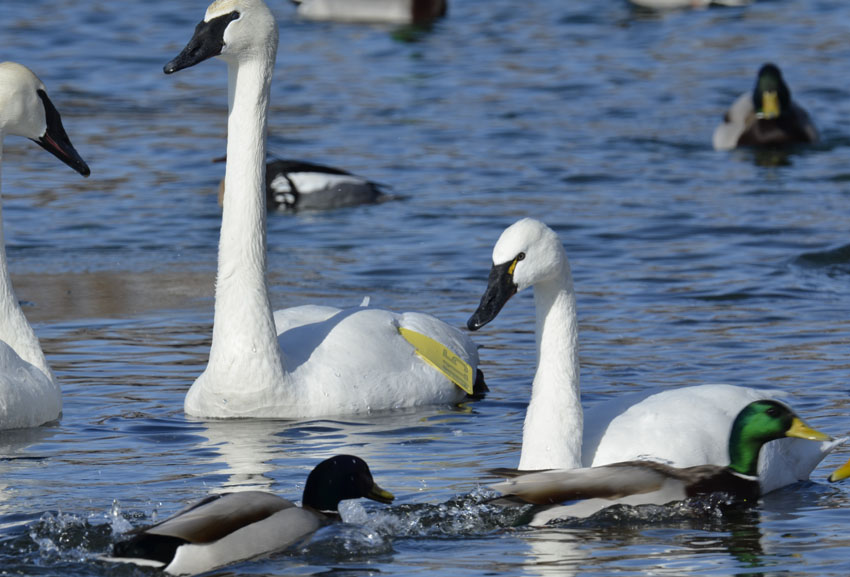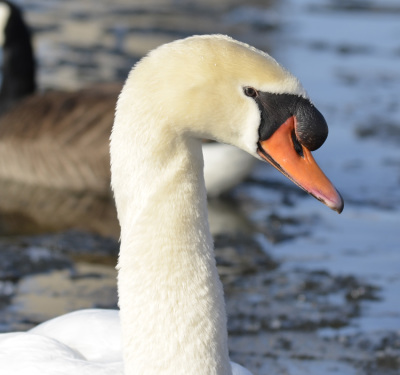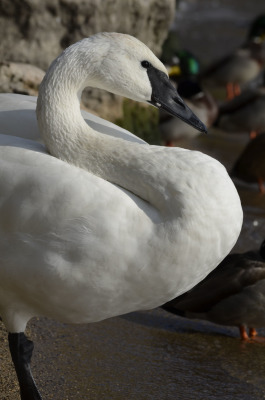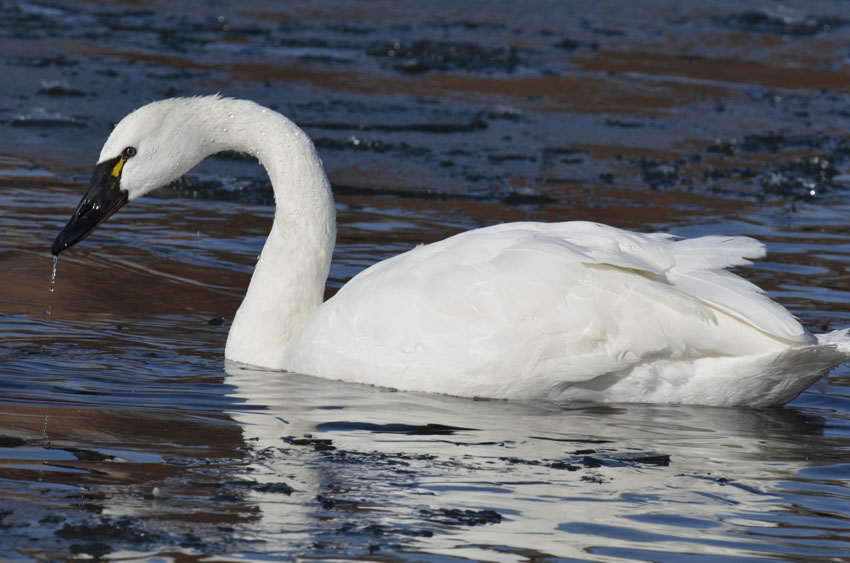An unusual opportunity to see all three of Ontario’s Swans in one place at close range arose recently in Toronto near the Leslie Street Spit. I couldn’t resist the chance to see a Tundra Swan up close so I went to take a gander. I’ve only (knowingly) seen Tundra Swans high overhead and far out in farmer’s corn fields before. This one had misplaced its peers and had joined several Trumpeter and Mute Swans at a small patch of open water for a few weeks.
The Three Faces on Ontario Swans
As I watched the birds, I worked on improving my skills at identifying the differences in their faces. Although there’s an obvious difference between the Tundras and Trumpeters in most cases, it isn’t always present.
This (below) is a Trumpeter Swan. They were killed off in Ontario but have been re-introduced through human intervention. Almost all of the Trumpeters seen in the Toronto area are these reintroduced birds who do not know where to migrate to and who often rely on humans to provide grain to keep them alive through the winter. The huge yellow wing tags on most of the birds are an obvious clue to their identity!
The bird beside it (or below it if your screen is narrow) is a Tundra Swan. As the name suggests, these birds nest in the far north and are only in the Toronto area on migration. For those of you with an older bird guide, these are what used to be called “Whistling Swans.”
At first glance there’s an obvious difference in the faces. Tundra Swans have the yellow teardrop near their eye. But not all Tundras do and in some cases it’s quite small. How else can you tell them apart?
Well, if they are this close, you can look for the other facial tips.
If you look at the line between the black and white on the Tundra swan from the eye to below the bill you will see it zigzags near the corner of the mouth. It almost makes a sideways W shape.
If you compare it to the Trumpeter Swan, you’ll see the Trumpeter Swan’s line between the white and black is a smooth curve like 1/4 of a circle.
I found the next difference harder to agree to. According to field guides, the black part going to the eye is narrower in the Tundra Swan than in the Trumpeter Swan. While it does look a bit like there’s more white above the black in front of the eye on the Tundra Swan, I wouldn’t say it’s a huge difference.
There are a few other differences in the guide but my photos don’t really show them well.
So it’s a good thing for me that the Tundras usually have that yellow mark near the eye and that the Trumpeters usually have big yellow wing tags!
Does this comparison photo remind anyone else of the joke about the black horse who was 5 hands taller than the white horse?
The other difference which was very obvious when the two types of swans were close together was the size difference. The Tundra Swan is noticeably smaller than the Trumpeter.
And their calls are different. Only the Trumpeter Swans sound like a beginner brass band trying to tune up. While I was there, however, the Tundra Swan never called.
Which Swans Are Native to Ontario
This third Swan face is a Mute Swan.
You can see they look significantly different than the native swans. The orange bill with the black knob is quite noticeable even from a distance. These are also the birds that raise their wings up over their backs like fluffy sails.
Mute Swans are introduced to North America. They were brought over as decorative birds and some have been released, on purpose and by accident, into the wild. They are actually spreading quite quickly which is upsetting to some landowners as they can be aggressive towards other birds and wildlife.
(This Trumpeter was at Lasalle Park in the fall of 2014.)
Trumpeters, as mentioned earlier, are native but the ones we see are re-introduced birds who have no knowledge of their ancestral flight paths and habits.
Tundra, formerly Whistling, Swans are the true native swan of Ontario still wild and free.
The Tundra Swan
I was very pleased to have an opportunity to see all three types of Swans at one time at close range. Thanks to the people who reported these birds via eBird so that I would find out about them before they flew.
Related Reading
- A Mink Meets Mute Swans on an October Afternoon
- Faces that Made Me Pause
- Why do the Swans Have Huge Yellow Numbered Tags on their Wings in Southern Ontario?
Join In
Do Tundra Swans fly over your home on their migration north? Are Mute Swans terrorizing the Canada Geese in a pond near you? Please share your experiences with a comment.










I have always looked for the trumpeter swan, Does the whistler make a noise? I know you cannot answer but we now live on a river instead of a lake it has all these wonderful and different living souls. anyways the mute swan although lovely is not the trumpeter to me. I will now look closer at the trumpeter to see if it is a tundra.
Yes, the Tundra/Whistling Swans calls are different than the Trumpeters.
Some good recordings are on the Cornell University website at
https://www.allaboutbirds.org/guide/Tundra_Swan/sounds
There are recordings of the European Bewick’s Swans too at
http://www.swansg.org/the-swans/bewicks/
They have recordings of the Trumpeter Swans at
https://www.allaboutbirds.org/guide/Trumpeter_Swan/sounds
I hope this helps a bit!
Thank you for this insightful information.
Joel Coutu